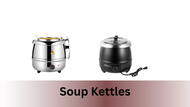Soup Kettles
Introduction
Soup kettles—also known as soup warmers, steam kettles, or tilt kettles—are vital pieces of commercial restaurant equipment designed to cook, hold, and dispense soups, sauces, stews, and other liquid-based dishes. Whether you're running a quick-serve café or a full-scale buffet, a proper soup kettle optimizes temperature control, portioning, and safety.
1. What Are Soup Kettles and Their Key Functions?
-
Primary Purpose
-
Designed to heat, cook, and maintain hot liquids at consistent serving temperatures.
-
Can be powered by electricity or gas; some use steam or direct induction.
-
-
Core Functions
-
Gentle, Uniform Heating: Prevents scorching or sticking—crucial for delicate soups or creamy sauces.
-
Precise Temperature Control: Thermostats or built-in probes regulate to perfect serving temps (usually 140–185 °F).
-
Large Batch Cooking: Capacities range from 6 quarts to over 12 gallons—ideal for high-output kitchens.
-
Easy Dispensing: Built-in spigots, tilting mechanisms, or ladle ladle wells help efficient portioning.
-
Versatile Use: Equally suited for broths, gravies, chilis, glazes, chowders, and even sautéing ingredients in thicker kettles.
-
2. Why Soup Kettles Are Essential Commercial Restaurant Equipment
-
Consistency & Quality
-
Maintains even heat, ensuring flavor and texture consistency across batches.
-
-
Labor Efficiency
-
Automates holding and dispensing—staff can easily serve without manual temperature adjustments.
-
-
Sanitation & Safety
-
Most models include easy-to-clean stainless-steel bowls and lids, reducing contamination risk.
-
-
Regulatory Compliance
-
Ideal for buffet lines, soup stations, catering services—we meet health code requirements for hot holding.
-
-
Integration with Restaurant Supply Fort Worth
-
Local suppliers in Fort Worth offer packages combining soup kettles with matching pan racks, steam tables, and sneeze guards for streamlined kitchen setup.
-
3. Which Types of Restaurants Benefit Most?
-
Buffets & Cafeterias
-
Serve multiple hot items simultaneously—soup kettles hold several options at proper temperatures, centralizing hot-station workflows.
-
-
Hotels & Conference Centers
-
Banquets and breakfast services rely on kettle lines for efficient flow and self-service friendly setups.
-
-
Catering Operations & Mobile Food Trucks
-
Portable, durable kettles maintain quality while on the move; gas-powered models are especially useful off-premises.
-
-
Cafés, Bistros, and Quick-Service Spots
-
Ideal for daily specials—tomato basil soup, chowders, or chili—streamlining prep and serving under busy demand.
-
-
Institutional Kitchens (Hospitals, Schools, Senior Living)
-
Nutritional soups and hot dishes can be batch-cooked and held safely, supporting dietary consistency and volume.
-
4. New vs. Used: Considering Used Restaurant Equipment
-
Cost Savings
-
Investing in used restaurant equipment like refurbished soup kettles is budget-friendly, especially for startups or expansion projects.
-
-
Things to Inspect in Used Units:
-
Heating Reliability: Confirm that thermostat and elements work properly.
-
Structural Integrity: Look for dents, corrosion, or leaky seals.
-
Sanitation Condition: Ensure all surfaces are cleanable and gasket/lid mechanisms function.
-
Compliance Labels: Verify NSF or UL listings plus local code compatibility.
-
-
Ideal Buyers for Used Units:
-
New catering businesses, food trucks entering operation, or backup equipment needs in busy establishments.
-
-
Risks to Mitigate
-
Lack of warranty or unseen wear. Buy from reputable restaurant supply Fort Worth dealers offering refurbishment and guarantees where possible.
-
5. Selecting the Right Soup Kettle: Key Considerations
| Factor | Recommendation |
|---|---|
| Capacity | Small café (6–10 qt), mid-volume (12–20 qt), high-volume buffet (30 qt +) |
| Power Type | Electric: plug-and-play, ideal for countertop areas. Gas: fast heat, mobile-friendly. Combos or steam models for large cook-line integration. |
| Heating Method | Direct-heated: simple, fast. Steam-jacketed: consistent, economizes energy and reduces scorching. |
| Dispensing Mechanism | Built-in spigot for speed; tilt mechanism for batch-serving; ladle with well for slower service. |
| Temperature Controls | Digital thermostats offer precision; manual knobs are simpler and robust. |
| Construction & Cleaning | Choose brushed stainless steel with rounded edges; removable parts speed sanitization. |
| Certifications | Look for NSF, UL, or ETL listings to ensure food safety and electrical/gas compliance. |
6. Best Practices: Use & Maintenance
-
Daily Routine
-
Clean thoroughly with mild detergent, ensuring spigot/lid edges are sanitized and dried.
-
Refill and preheat before service periods to avoid delays.
-
-
Weekly/Periodic Care
-
Inspect gaskets, tighten hardware, descale heating elements (if applicable), and verify temperature accuracy.
-
-
Safe Operation Tips
-
Never run dry—risk of damage. Use water/stock before heating.
-
Use non-metal utensils to protect seals and coatings.
-
Turn off between services to conserve energy and extend component life.
-
Conclusion
Soup kettles are indispensable in many food-service environments, ensuring consistent quality, safety, and efficiency—attributes that modern kitchens demand. Whether you source a brand-new unit or explore used restaurant equipment options through trusted restaurant supply Fort Worth providers, identifying your volume needs, power setup, and service style will guide you to the right kettle. With proper choice, cleaning, and care, your soup kettle will be a reliable backbone of your hot-food service, batch after batch.

